1. Introduction
Starting your own fashion line is an exciting yet challenging journey that blends creativity, business acumen, and perseverance. Many successful designers, from Virgil Abloh to Stella McCartney, began with a vision and gradually built their brands through innovation, strategic planning, and understanding of market trends. The fashion industry demands not just artistic talent but also a deep grasp of production, branding, and consumer psychology. Learning from those who have navigated this path can provide invaluable insights, whether it’s about defining a unique aesthetic, leveraging social media for exposure, or securing the right manufacturing partners. As Marc Jacobs once said, “Clothing is a form of self-expression—there are hints about who you are in what you wear” (Jacobs, n.d.; Abloh, 2019; McCartney, 2018).
Overview of the Fashion Industry: The Opportunities and Challenges
The fashion industry is a dynamic and ever-evolving sector that offers immense opportunities alongside significant challenges. On the one hand, it is a multi-trillion-dollar industry that thrives on creativity, global consumer demand, and digital transformation, providing emerging designers with various entry points through e-commerce, social media marketing, and sustainable fashion trends. The rise of fast fashion, influencer collaborations, and direct-to-consumer models has lowered traditional barriers, allowing independent brands to compete with established names. On the other hand, challenges such as supply chain disruptions, sustainability concerns, and the highly competitive nature of the market require designers to be not only creative but also strategic. The increasing demand for ethical fashion and technological integration, such as AI-driven design and virtual fashion shows, further reshapes industry norms. As Coco Chanel once said, “In order to be irreplaceable, one must always be different”—a reminder that standing out in this crowded space requires both innovation and resilience (McKinsey & Company, 2023; PWC, 2022; Chanel, n.d.).
Why Start a Fashion Line? Personal Creativity, Passion for Fashion, and Potential for Impact
Starting a fashion line offers a rare blend of personal creativity, industry influence, and entrepreneurial opportunity. For many, fashion is not just about clothing—it’s a medium to express identity, challenge norms, and tell compelling stories. Whether driven by a passion for design, a commitment to ethical production, or a vision for redefining trends, launching a brand provides a platform to shape cultural conversations and consumer behavior. Additionally, with the growing demand for unique, sustainable, and niche fashion, independent designers now have more opportunities than ever to make a mark in the industry. While competition is fierce, digital tools, e-commerce, and direct-to-consumer models have lowered barriers to entry, making it possible for creative entrepreneurs to build successful brands with a global reach (McKinsey & Company, 2023; Business of Fashion, 2022; PWC, 2021).
Inspiration from Successful Designers: How Established Designers Paved Their Paths
Many of today’s most influential designers started with little more than a vision and a relentless drive to bring their ideas to life. Virgil Abloh, for instance, leveraged his background in architecture and deep understanding of street culture to redefine luxury fashion, proving that blending high fashion with streetwear could disrupt the industry. Stella McCartney, on the other hand, built her brand on sustainability long before it became mainstream, setting new standards for ethical fashion. Meanwhile, designers like Tom Ford and Donatella Versace expanded their brands by mastering the art of branding, marketing, and understanding consumer psychology. The key takeaway from their journeys is that success in fashion is rarely linear—it requires adaptability, persistence, and a strong brand identity. Whether through innovative designs, strategic collaborations, or digital engagement, these designers have demonstrated that a clear vision and commitment to authenticity are essential for long-term success (Abloh, 2019; McCartney, 2018; Business of Fashion, 2023; Vogue, 2022).
2. Laying the Foundation
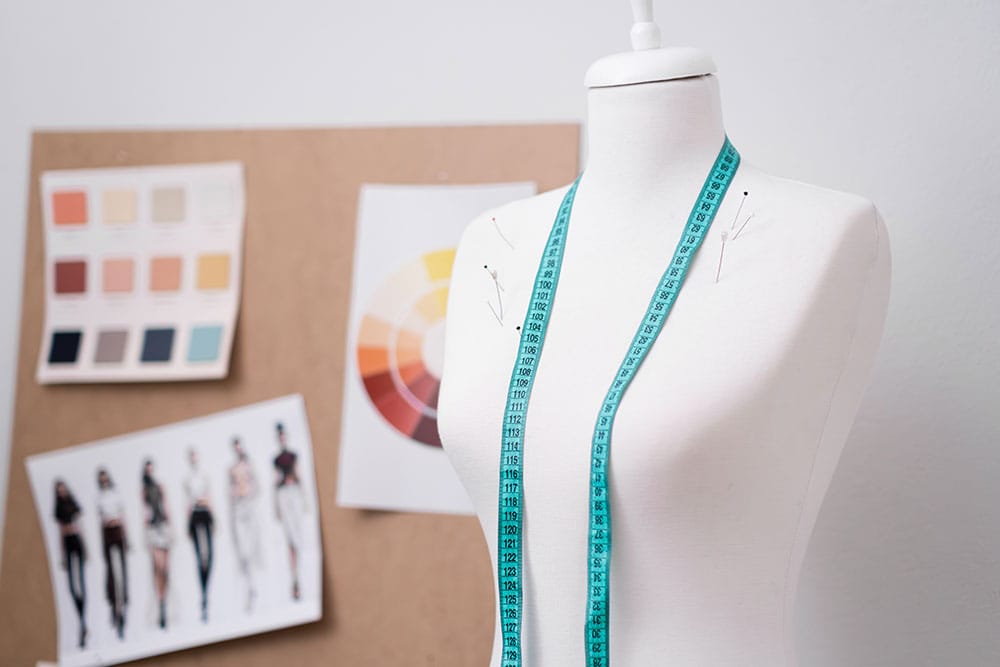
Building a successful fashion brand starts with a strong foundation, where vision, strategy, and market understanding come together. Defining a clear brand identity is essential—whether it’s a focus on luxury, sustainability, streetwear, or inclusivity, every successful fashion label is built on a distinct aesthetic and message. Conducting market research helps identify gaps in the industry and ensures that the brand resonates with the right audience. Additionally, developing a solid business plan that covers funding, production, pricing strategies, and distribution channels is crucial for long-term growth. Many designers, like Christian Dior and Ralph Lauren, started with a well-defined vision before expanding into global empires, proving that meticulous planning and a strong foundation are key to success in the industry (McKinsey & Company, 2023; Business of Fashion, 2022; PWC, 2021).
Define Your Vision: Establishing Your Unique Aesthetic and Mission
Defining your vision is the first and most crucial step in building a fashion brand that stands out in a highly competitive industry. A strong fashion brand is more than just clothing—it’s a reflection of a designer’s values, creativity, and purpose. Whether focusing on minimalism, avant-garde aesthetics, or sustainability, a clear and cohesive brand identity helps connect with the right audience and differentiate from competitors. Establishing a mission statement is equally important, as it guides the brand’s direction and long-term goals. Successful designers like Alexander McQueen and Stella McCartney built their legacies on distinct design philosophies—McQueen’s dramatic storytelling and McCartney’s commitment to ethical fashion set them apart. By defining a unique aesthetic and mission from the outset, aspiring designers can create a brand that is both impactful and recognizable (Business of Fashion, 2023; McKinsey & Company, 2022; Vogue, 2021).
Research the Market: Understanding Industry Trends and Target Audiences
Thorough market research is essential for launching a fashion brand that resonates with consumers and stays ahead of industry trends. Understanding market dynamics helps designers identify opportunities, analyze competition, and anticipate shifts in consumer behavior. Key areas to explore include emerging fashion trends, sustainability demands, digital retail growth, and evolving consumer preferences. Studying competitors—both established brands and independent labels—can provide insights into pricing strategies, branding techniques, and gaps in the market. Additionally, defining a target audience based on demographics, lifestyle, and purchasing habits ensures that marketing efforts and product designs align with consumer expectations. Brands like Zara and Off-White have mastered the art of trend analysis and consumer engagement, proving that staying informed and adaptable is key to long-term success in fashion (McKinsey & Company, 2023; Business of Fashion, 2022; Statista, 2021).
Identify Your Niche: Specializing in a Specific Segment (e.g., sustainable fashion, luxury, streetwear, or plus-size clothing)
Identifying a niche is crucial for building a fashion brand that stands out in an oversaturated market. Instead of trying to appeal to everyone, successful designers focus on a specific segment that aligns with their expertise, vision, and consumer demand. Whether it’s sustainable fashion, luxury couture, streetwear, plus-size clothing, or gender-neutral apparel, choosing the right niche helps create a strong brand identity and loyal customer base. Specialization allows designers to refine their craft, connect deeply with their audience, and market their products effectively. For instance, brands like Patagonia have thrived by prioritizing eco-friendly materials, while Supreme has built an empire around exclusive streetwear drops. Finding the right balance between creativity and market demand ensures that a brand remains both unique and commercially viable (McKinsey & Company, 2023; Business of Fashion, 2022; Vogue, 2021).
3. Building Your Brand Identity

Building a strong brand identity is essential for establishing a recognizable and influential fashion label. A brand is more than just a logo or a name—it’s the story, values, and emotions that connect with consumers on a deeper level. From selecting a unique brand name and crafting a compelling logo to developing a signature design style and brand voice, every element should reflect the essence of the label. Successful fashion brands like Chanel, Off-White, and Jacquemus have built their identities by maintaining a consistent aesthetic and clear messaging across all touchpoints, from packaging to social media. Creating a compelling brand story that highlights the inspiration, mission, and vision behind the brand also helps foster loyalty and emotional engagement with customers. In an era where authenticity is key, brands that communicate their values effectively tend to attract a dedicated following and stand out in the crowded fashion landscape (Business of Fashion, 2023; McKinsey & Company, 2022; Harvard Business Review, 2021).
Crafting a Memorable Brand Name: The Importance of Originality and Relevance
Choosing the right brand name is a critical step in building a strong fashion identity, as it sets the tone for how consumers perceive the brand. A memorable name should be original, relevant, and aligned with the brand’s aesthetic and values. It should be easy to pronounce, spell, and recall while avoiding generic or overused words that may dilute its uniqueness. Many successful brands, such as Balenciaga, Gucci, and Nike, have leveraged distinctive names that evoke strong associations with luxury, innovation, or performance. Additionally, conducting thorough research to ensure the name isn’t already trademarked or in use is crucial to avoid legal issues down the line. A well-chosen name not only establishes brand recognition but also helps create an emotional connection with the target audience, making it a powerful tool for long-term success (Harvard Business Review, 2022; Business of Fashion, 2023; McKinsey & Company, 2021).
Designing a Logo and Visuals: First Impressions and Cohesive Branding
A well-designed logo and cohesive visual identity are crucial for making a lasting first impression and establishing brand recognition in the fashion industry. A strong logo should be simple, memorable, and reflective of the brand’s aesthetic—whether minimalistic like Celine, bold like Nike’s swoosh, or intricate like Versace’s Medusa emblem. Beyond the logo, cohesive branding includes color schemes, typography, and packaging design, all of which contribute to a unified and recognizable brand identity. Visual consistency across websites, social media, and product packaging reinforces brand recall and helps build consumer trust. Studies show that brands with consistent visuals are perceived as more professional and credible, increasing customer loyalty. As the fashion industry is highly visual, investing in strong, well-thought-out branding can set a brand apart in a competitive market (Business of Fashion, 2023; Harvard Business Review, 2022; McKinsey & Company, 2021).
Creating a Story: Communicating Your Values and the Inspiration Behind Your Line
A compelling brand story is the heart of a successful fashion line, shaping how consumers connect with the brand on an emotional level. It’s not just about selling clothes—it’s about sharing a vision, values, and the inspiration behind the designs. Whether rooted in personal experiences, cultural heritage, sustainability, or a bold mission to challenge industry norms, an authentic story helps create a deeper bond with the target audience. Brands like Patagonia, with its commitment to environmental activism, or Alexander McQueen, known for his dramatic and rebellious artistic vision, have built loyal followings by communicating strong narratives. A well-crafted brand story should be consistently reflected across all touchpoints, from product descriptions and social media to packaging and advertising campaigns. In today’s saturated market, consumers are drawn to brands with purpose, making storytelling a powerful tool for differentiation and long-term brand loyalty (Harvard Business Review, 2022; Business of Fashion, 2023; McKinsey & Company, 2021).
4. Designing Your Collection

Designing a fashion collection is where creativity meets strategy, bringing your brand vision to life through cohesive and wearable pieces. A successful collection isn’t just about individual garments—it tells a story, follows a clear aesthetic, and resonates with the target audience. From selecting fabrics and colors to balancing creativity with functionality, every detail should align with the brand identity. Designers like Coco Chanel and Ralph Lauren have mastered the art of creating collections that reflect their core philosophy while staying relevant to evolving market trends. Additionally, considering factors like seasonality, sustainability, and production feasibility ensures that the collection is both innovative and commercially viable. A well-curated collection builds anticipation, strengthens brand identity, and sets the foundation for long-term success in the competitive fashion industry (Business of Fashion, 2023; McKinsey & Company, 2022; Vogue, 2021).
Sketching Your Ideas: From Rough Sketches to Detailed Designs
Sketching is the first step in transforming creative concepts into tangible designs, allowing fashion designers to visually explore their ideas before production. The process typically begins with rough sketches, also known as croquis, which serve as quick representations of silhouettes, proportions, and garment details. As the ideas evolve, these sketches become more refined, incorporating precise details such as fabric choices, stitching techniques, and embellishments. Many successful designers, like Karl Lagerfeld and Christian Dior, relied heavily on hand-drawn sketches to communicate their visions before translating them into physical samples. Today, digital tools like Adobe Illustrator and CLO 3D complement traditional sketching, enabling designers to create more precise and dynamic representations of their designs. Whether done by hand or digitally, sketching is an essential part of the creative process, bridging the gap between imagination and final production (Business of Fashion, 2023; McKinsey & Company, 2022; Vogue, 2021).
Selecting Fabrics and Materials: Balancing Quality, Cost, and Sustainability
Selecting the right fabrics and materials is a crucial step in designing a fashion collection, as it directly impacts the quality, aesthetics, and sustainability of the final product. The choice of textiles should align with the brand’s identity—whether focusing on luxury, durability, or eco-conscious fashion. Designers must balance quality, cost, and sustainability, ensuring that materials not only look and feel premium but are also practical for production and pricing strategies. For example, luxury brands like Hermès prioritize high-quality natural fibers such as silk and cashmere, while sustainable labels like Stella McCartney opt for innovative materials like organic cotton and vegan leather. Additionally, sourcing responsibly—from certified suppliers or recycled fabrics—can enhance a brand’s ethical appeal and meet the growing consumer demand for sustainability. Understanding fabric properties such as weight, drape, and breathability is also essential for ensuring that the chosen materials align with the intended design and functionality of the garments (Business of Fashion, 2023; McKinsey & Company, 2022; Textile Exchange, 2021).
Choosing a Theme: Cohesion Across the Collection
Choosing a theme is essential for creating a cohesive and impactful fashion collection, as it provides a unifying concept that ties all the pieces together. A strong theme can be inspired by cultural influences, historical references, emotions, seasons, or even abstract ideas. For instance, Alexander McQueen’s collections often explored dark romanticism and rebellion, while Chanel’s classic aesthetic draws from Parisian elegance and timeless sophistication.A well-defined theme ensures that colors, silhouettes, fabrics, and design details harmonize across the collection, making it visually compelling and commercially viable. It also helps in branding and marketing, allowing designers to tell a consistent story through their collection. Whether it’s a minimalist monochrome line, a bohemian-inspired summer collection, or a futuristic streetwear drop, staying true to a central concept strengthens the collection’s identity and appeal. Successful designers understand that consistency doesn’t mean repetition—it’s about creating a diverse range of pieces that feel connected yet distinct (Business of Fashion, 2023; McKinsey & Company, 2022; Vogue, 2021).
Prototyping and Sampling: Testing Designs for Practicality and Quality
Prototyping and sampling are essential steps in transforming sketches into wearable garments, ensuring that designs are both practical and high quality before full-scale production. This phase involves creating initial samples, or prototypes, to test fit, fabric behavior, construction techniques, and overall functionality. Designers and manufacturers collaborate to refine details, adjusting patterns, seams, and stitching to enhance comfort, durability, and aesthetic appeal.
High-end brands like Dior and Prada invest heavily in sampling to perfect garment structures, while fast fashion brands prioritize cost-effective prototyping for rapid production. Modern technology, such as 3D fashion design software like CLO 3D, has also streamlined this process, reducing material waste and improving efficiency. By thoroughly testing and refining prototypes, designers can minimize costly production errors, ensure consistency in manufacturing, and deliver a final product that meets both creative and commercial expectations (Business of Fashion, 2023; McKinsey & Company, 2022; Textile Exchange, 2021).
5. Building a Team
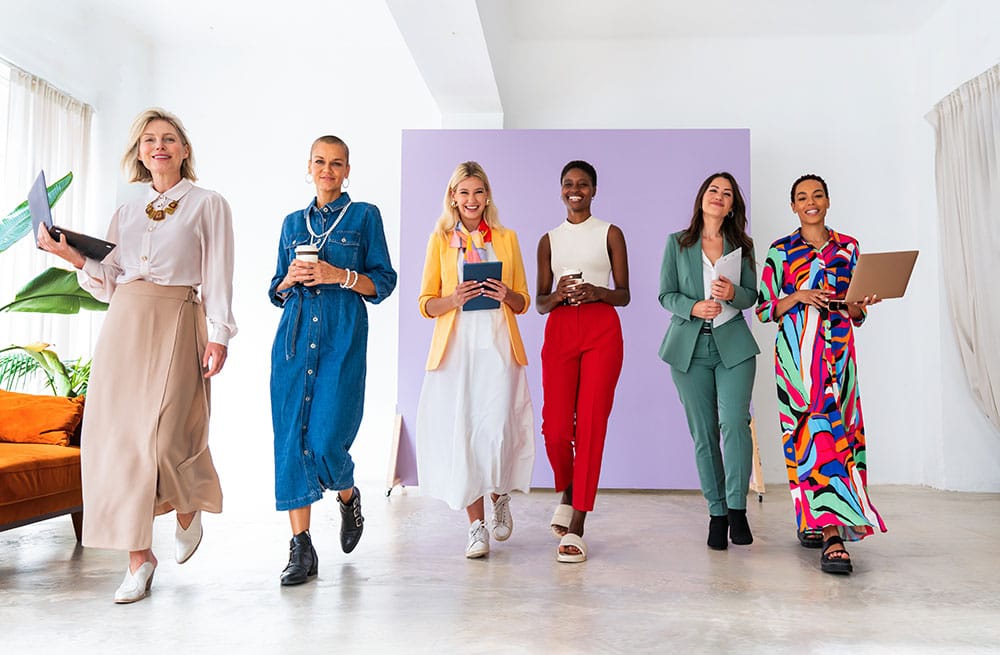
Building a strong team is crucial for transforming a fashion concept into a successful brand. While creativity is at the heart of fashion, execution requires a mix of design, business, and operational expertise. A well-rounded team typically includes designers, pattern makers, production managers, marketing specialists, and sales strategists, each playing a key role in bringing the brand to life.
Hiring the right people ensures that designs are executed flawlessly, supply chains run smoothly, and marketing strategies reach the right audience. Many successful designers, such as Tom Ford and Virgil Abloh, surrounded themselves with skilled professionals who helped scale their vision into global brands. Whether outsourcing or building an in-house team, selecting individuals who align with the brand’s mission and work ethic is essential for long-term success. Collaboration, communication, and a shared passion for the brand’s vision make a fashion business more adaptable and competitive in an evolving industry (Business of Fashion, 2023; McKinsey & Company, 2022; Harvard Business Review, 2021).
Hiring Key Roles: Designers, Pattern Makers, Tailors, and Marketers
Hiring key roles in a fashion brand is essential for ensuring a smooth transition from concept to final product. A strong team brings together creative vision, technical expertise, and business strategy, allowing the brand to thrive in a competitive industry. Some of the most crucial roles include:
- Fashion Designers – Responsible for conceptualizing collections, sketching designs, and selecting materials. Designers set the brand’s aesthetic and innovation direction.
- Pattern Makers – Experts in turning sketches into technical patterns, ensuring accurate fit and garment construction. They work closely with designers and tailors.
- Tailors & Seamstresses – Skilled artisans who sew and assemble garments, focusing on quality craftsmanship and attention to detail.
- Production Managers – Oversee the manufacturing process, ensuring timelines, budgets, and quality standards are met.
- Marketing & Branding Specialists – Responsible for brand positioning, digital marketing, and social media strategy to connect with target audiences and drive sales.
Successful fashion houses, such as Dior and Balmain, owe much of their success to well-structured teams with expertise in each of these areas. Whether hiring in-house, outsourcing, or collaborating with freelancers, assembling the right talent ensures efficiency, creativity, and a competitive edge in the market (Business of Fashion, 2023; McKinsey & Company, 2022; Vogue, 2021).
Outsourcing vs. In-House Production: Pros and Cons of Manufacturing Approaches
Choosing between outsourcing and in-house production is a critical decision that impacts a fashion brand’s quality, costs, and scalability. Both approaches have distinct advantages and challenges, depending on the brand’s goals, budget, and operational capacity.
1. Outsourcing Production
✅ Pros:
- Lower Costs: Manufacturing in countries with lower labor costs (e.g., China, India, or Portugal) can reduce expenses.
- Scalability: Easier to ramp up production quickly based on demand.
- Access to Expertise: Many third-party manufacturers specialize in high-quality craftsmanship, sustainable materials, or specific techniques.
❌ Cons:
- Less Control: Quality, production timelines, and ethical standards can be harder to manage.
- Minimum Order Quantities (MOQs): Many manufacturers require large orders, which may not be feasible for small brands.
- Longer Lead Times: Shipping and communication with overseas manufacturers can slow production.
2. In-House Production
✅ Pros:
- Quality Control: Full oversight of materials, stitching, and finishing ensures consistency.
- Faster Turnaround: Reduces delays and allows for flexible adjustments.
- Sustainability & Ethical Transparency: Brands can ensure fair labor practices and sustainable sourcing.
❌ Cons:
- High Initial Investment: Setting up a production facility requires significant capital for equipment and labor.
- Limited Scalability: Expanding production requires hiring more staff and increasing resources.
- Operational Complexity: Managing production, supply chain, and quality assurance adds to business challenges.
Many successful brands use a hybrid approach, keeping high-end or custom pieces in-house while outsourcing mass production. For example, Chanel controls its couture production in-house for quality, while brands like Nike and Zara outsource manufacturing to maintain cost efficiency and high output. Choosing the right model depends on the brand’s priorities—cost efficiency, creative control, or ethical transparency (Business of Fashion, 2023; McKinsey & Company, 2022; Harvard Business Review, 2021).
Collaborating with Freelancers: Working with Photographers, Graphic Designers, and Social Media Experts
Collaborating with freelancers allows fashion brands to bring in specialized expertise in key areas like photography, graphic design, and social media marketing without the long-term commitment of a full-time team. In an industry where visual storytelling is crucial, working with skilled photographers ensures that campaign images, lookbooks, and product shots align with the brand’s aesthetic and appeal to the target audience. Similarly, graphic designers help create cohesive branding elements, from logos and packaging to website layouts and promotional materials.
Freelancers also play a significant role in digital marketing, with social media experts curating content, managing influencer partnerships, and crafting engagement strategies to increase brand visibility. Platforms like Instagram, TikTok, and Pinterest have become major marketing channels for fashion brands, making professional content creation a priority. Many successful independent designers, such as Simon Porte Jacquemus, started small but leveraged creative freelancers to establish a strong brand presence before expanding. Building good relationships with talented freelancers ensures a steady flow of high-quality content, helping brands remain competitive and visually compelling in the fast-paced fashion industry (Business of Fashion, 2023; McKinsey & Company, 2022; Vogue, 2021).
6. Understanding the Business Side

While creativity is at the heart of fashion, understanding the business side is essential for turning a brand into a sustainable and profitable venture. From setting up a legal structure to managing finances, pricing strategies, and marketing, a solid business foundation ensures long-term success. Many independent designers fail not because of a lack of talent but due to financial mismanagement or poor strategic planning.
A key aspect of running a fashion business is determining the right business model—whether direct-to-consumer (DTC), wholesale, or a mix of both. Additionally, understanding cost structures, production expenses, and profit margins helps in setting competitive yet profitable pricing. Branding and marketing also play a major role, as strong storytelling and digital presence can drive customer engagement and sales. Designers like Virgil Abloh and Stella McCartney not only built strong aesthetics but also understood market positioning, strategic partnerships, and financial planning to scale their brands successfully.
Having a well-thought-out business plan that covers funding options, operational logistics, and growth strategies can make the difference between a short-lived brand and a long-term fashion powerhouse (Business of Fashion, 2023; McKinsey & Company, 2022; Harvard Business Review, 2021).
Creating a Business Plan: Budgeting, Financial Projections, and Growth Strategies
A solid business plan is the foundation of a successful fashion brand, outlining key aspects such as budgeting, financial projections, and growth strategies. It helps designers manage expenses—covering materials, production, marketing, and logistics—while ensuring sustainable pricing and profitability. Financial projections provide insight into revenue goals and breakeven points, helping brands make informed decisions. Additionally, a clear marketing and sales strategy, including digital outreach and retail distribution, ensures brand visibility and customer engagement. Many independent labels, like Jacquemus, scaled successfully by combining creative vision with smart financial planning. A well-structured plan not only keeps operations on track but also attracts investors and retail partners, paving the way for long-term growth (Business of Fashion, 2023; McKinsey & Company, 2022; Harvard Business Review, 2021).
Funding Your Fashion Line: Bootstrapping, Loans, or Investor Backing
Securing funding is a crucial step in launching a fashion brand, with options ranging from bootstrapping, loans, and investor backing, each offering distinct advantages. Bootstrapping, or self-funding, allows full creative and financial control but requires careful budgeting and gradual growth. Bank loans and grants provide capital without giving up ownership, though they require strong financial planning and repayment strategies. Investor backing, including venture capital or angel investors, offers significant funding for scaling but often involves relinquishing some control and meeting investor expectations. Many successful brands, such as Reformation and Off-White, started small and strategically scaled through a mix of these methods. Choosing the right funding strategy depends on the brand’s financial goals, risk tolerance, and long-term vision (Business of Fashion, 2023; McKinsey & Company, 2022; Harvard Business Review, 2021).
Understanding Legal Requirements: Registering Your Business, Trademarks, and Copyrights
Navigating legal requirements is essential for protecting a fashion brand and ensuring compliance with industry regulations. Registering the business—whether as a sole proprietorship, LLC, or corporation—establishes its legal structure and tax obligations. Trademarks safeguard brand names, logos, and unique designs from unauthorized use, while copyrights protect original prints, patterns, and artistic elements. Additionally, securing manufacturing and retail agreements helps prevent legal disputes with suppliers and distributors. Many successful brands, like Louis Vuitton, have aggressively defended their trademarks to maintain exclusivity. Ensuring proper legal protections from the start prevents costly issues down the line and strengthens the brand’s market position (Business of Fashion, 2023; McKinsey & Company, 2022; Harvard Business Review, 2021).
7. Manufacturing and Production
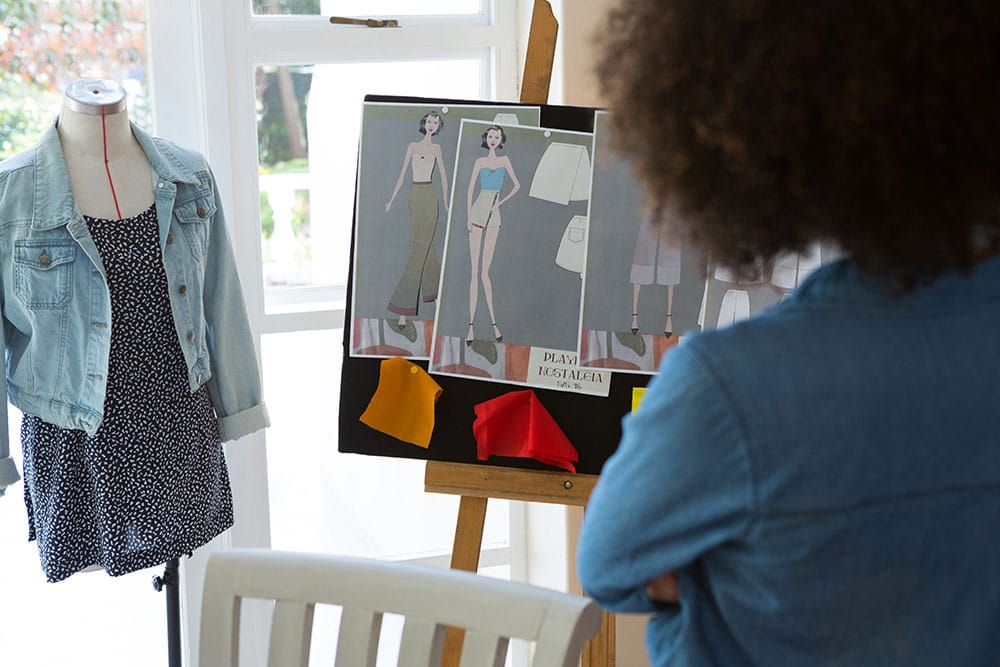
Efficient manufacturing and production are key to turning fashion designs into high-quality, market-ready garments. Choosing the right production model—whether small-batch, made-to-order, or mass manufacturing—depends on the brand’s budget, sustainability goals, and target market. Partnering with reliable manufacturers and suppliers ensures consistency in fabric quality, craftsmanship, and delivery timelines. Factors like ethical labor practices, material sourcing, and production scalability play a crucial role in long-term success. Brands like Everlane and Stella McCartney have built strong reputations by prioritizing transparency and sustainability in production. Careful planning in this phase helps maintain quality, control costs, and streamline operations for a smooth transition from design to retail (Business of Fashion, 2023; McKinsey & Company, 2022; Vogue, 2021).
Finding the Right Manufacturer: Local vs. Overseas Production
Choosing the right manufacturer is crucial for ensuring quality, cost efficiency, and scalability, with the main decision being between local and overseas production. Local manufacturing offers benefits like faster turnaround times, easier quality control, and ethical labor transparency, making it ideal for luxury or sustainable brands. However, it often comes with higher production costs and limited scalability. Overseas production, in countries like China, Bangladesh, or Portugal, provides lower costs and larger production capacity, but challenges include longer lead times, potential quality inconsistencies, and ethical concerns. Many brands, like Nike and Zara, use a hybrid approach—outsourcing mass production while keeping high-end or limited-edition pieces local. The right choice depends on the brand’s budget, values, and long-term vision (Business of Fashion, 2023; McKinsey & Company, 2022; Vogue, 2021).
Setting Up Quality Control: Ensuring Consistency and Reliability
Quality control is essential in fashion manufacturing to maintain consistency, durability, and brand reputation. Implementing a structured inspection process at various stages—fabric sourcing, sample development, and final production—helps identify defects early. Establishing clear production guidelines for stitching, sizing, and finishing ensures uniformity across all pieces. Many brands use third-party quality control services or in-house teams to monitor compliance with industry standards. High-end labels like Chanel and Hermès invest heavily in craftsmanship oversight to uphold their luxury status, while mass-market brands enforce standardized quality checks to prevent defects at scale. A strong quality assurance system reduces returns, enhances customer satisfaction, and strengthens brand trust (Business of Fashion, 2023; McKinsey & Company, 2022; Vogue, 2021).
Managing Inventory: Efficient Production Runs and Minimizing Waste
Managing inventory effectively is crucial for balancing supply and demand, minimizing waste, and maintaining profitability. Fashion brands must optimize production runs based on sales forecasts, ensuring they produce enough to meet demand without overstocking. Implementing a just-in-time (JIT) inventory system reduces excess stock and storage costs, while pre-orders and made-to-order models help brands like Jacquemus and Reformation minimize waste. Digital tools like inventory management software track stock levels in real-time, preventing shortages or overproduction. Sustainable brands also repurpose unsold materials to reduce environmental impact. A well-structured inventory strategy ensures smoother operations, better cash flow, and a more sustainable production cycle (Business of Fashion, 2023; McKinsey & Company, 2022; Vogue, 2021).
8. Marketing and Launching Your Brand
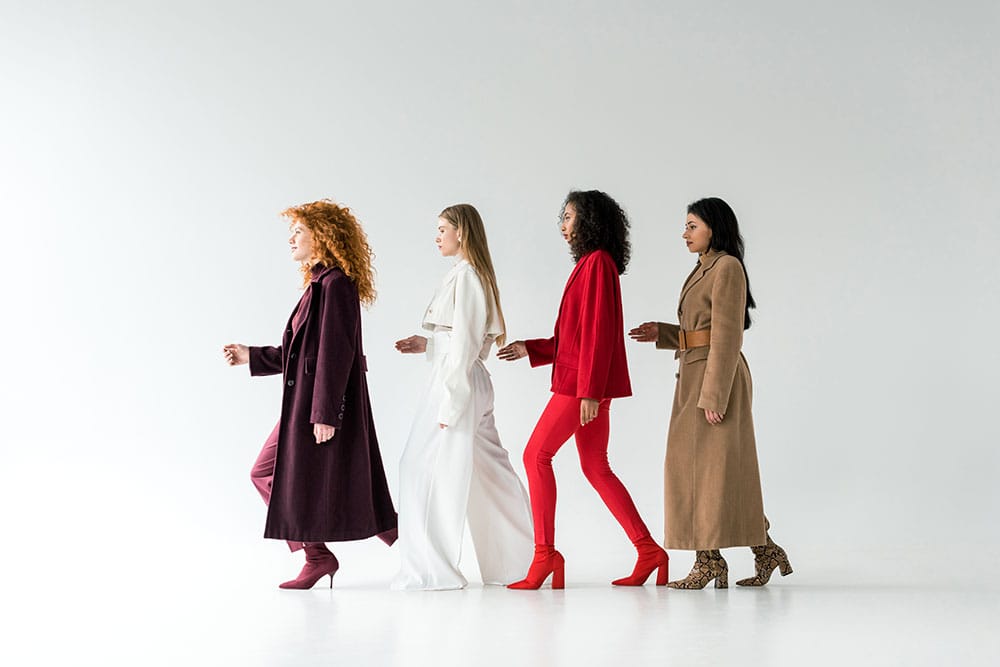
Successfully marketing and launching your fashion brand is key to building visibility, attracting customers, and establishing a strong industry presence. A well-crafted launch strategy includes brand storytelling, digital marketing, influencer collaborations, and strategic partnerships to create buzz. Social media platforms like Instagram, TikTok, and Pinterest have become essential for showcasing collections, engaging with audiences, and driving sales. Brands like Jacquemus and Skims have leveraged digital-first marketing strategies to create viral campaigns and cultivate loyal communities. Beyond digital efforts, pop-up events, fashion shows, and PR outreach help generate excitement and position the brand within the industry. A successful launch isn’t just about selling products—it’s about creating an experience that resonates with customers and sets the foundation for long-term brand loyalty (Business of Fashion, 2023; McKinsey & Company, 2022; Vogue, 2021).
Building an Online Presence: Setting Up a Website and Utilizing Social Media
A strong online presence is essential for a modern fashion brand, combining a professional website with strategic social media marketing to reach and engage customers. A well-designed website should be visually appealing, easy to navigate, and optimized for e-commerce, featuring high-quality product images, a seamless checkout process, and clear brand storytelling. Platforms like Shopify, Squarespace, and WooCommerce provide user-friendly solutions for launching an online store.
On social media, brands leverage Instagram for visual storytelling, TikTok for viral marketing, Pinterest for inspiration, and LinkedIn for industry networking. Engaging content—such as behind-the-scenes videos, styling tips, and influencer collaborations—helps build brand awareness and trust. Successful brands like Skims and Jacquemus have mastered digital engagement by creating authentic, interactive content that resonates with their audiences. By combining a well-structured website with a dynamic social media strategy, fashion brands can drive traffic, increase sales, and establish a loyal community (Business of Fashion, 2023; McKinsey & Company, 2022; Vogue, 2021).
Leveraging Influencers and Collaborations: Partnering with Personalities to Boost Visibility
Leveraging influencers and collaborations is a powerful way to boost brand visibility, build credibility, and drive sales in the fashion industry. Partnering with fashion influencers, celebrities, or niche content creators allows brands to tap into engaged audiences and gain organic exposure. Micro-influencers, with smaller but highly loyal followings, often provide higher engagement rates and a more authentic connection with consumers, while mega-influencers and celebrities bring wider reach and brand prestige.
Strategic collaborations—whether with designers, artists, or other brands—also create buzz and exclusivity. Iconic partnerships like Adidas x Yeezy or H&M x Balmain have demonstrated how well-executed collaborations can generate massive demand and brand loyalty. Successful influencer marketing isn’t just about visibility; it’s about choosing partners who genuinely align with the brand’s aesthetic and values, ensuring authenticity and long-term impact (Business of Fashion, 2023; McKinsey & Company, 2022; Vogue, 2021).
Creating a Lookbook: A Professional Showcase of Your Collection
A lookbook is an essential marketing tool that professionally showcases a fashion collection, helping to define the brand’s aesthetic and attract buyers, press, and customers. A well-crafted lookbook features high-quality photography, carefully styled outfits, and a consistent visual theme that tells the story behind the collection. Whether digital or print, the layout should be clean and minimal, allowing the garments to stand out while reflecting the brand’s identity. Successful brands like Jacquemus and Acne Studios use lookbooks to create immersive experiences, blending fashion with artistic direction. Including detailed garment descriptions, styling suggestions, and a clear call to action enhances engagement and drives sales. A strong lookbook not only elevates brand perception but also serves as a key promotional asset for retailers, media, and online marketing campaigns (Business of Fashion, 2023; McKinsey & Company, 2022; Vogue, 2021).
Participating in Fashion Events: Trade Shows, Pop-ups, and Fashion Weeks
Participating in fashion events is a crucial step in gaining industry recognition, networking with buyers, and increasing brand visibility. Trade shows like Première Vision and MAGIC provide opportunities to connect with retailers and suppliers, while pop-up shops create exclusive, immersive experiences that engage customers directly. For emerging designers, showcasing at fashion weeks—whether at major events like Paris, Milan, or New York Fashion Week, or smaller regional shows—helps position the brand within the industry and attract media attention. Many independent brands, like Pyer Moss and Thebe Magugu, gained recognition through strategic event participation, using runway presentations and interactive activations to generate buzz. These events serve as powerful platforms for brand storytelling, networking, and direct customer engagement, making them invaluable for both exposure and business growth (Business of Fashion, 2023; McKinsey & Company, 2022; Vogue, 2021).
9. Selling Your Products
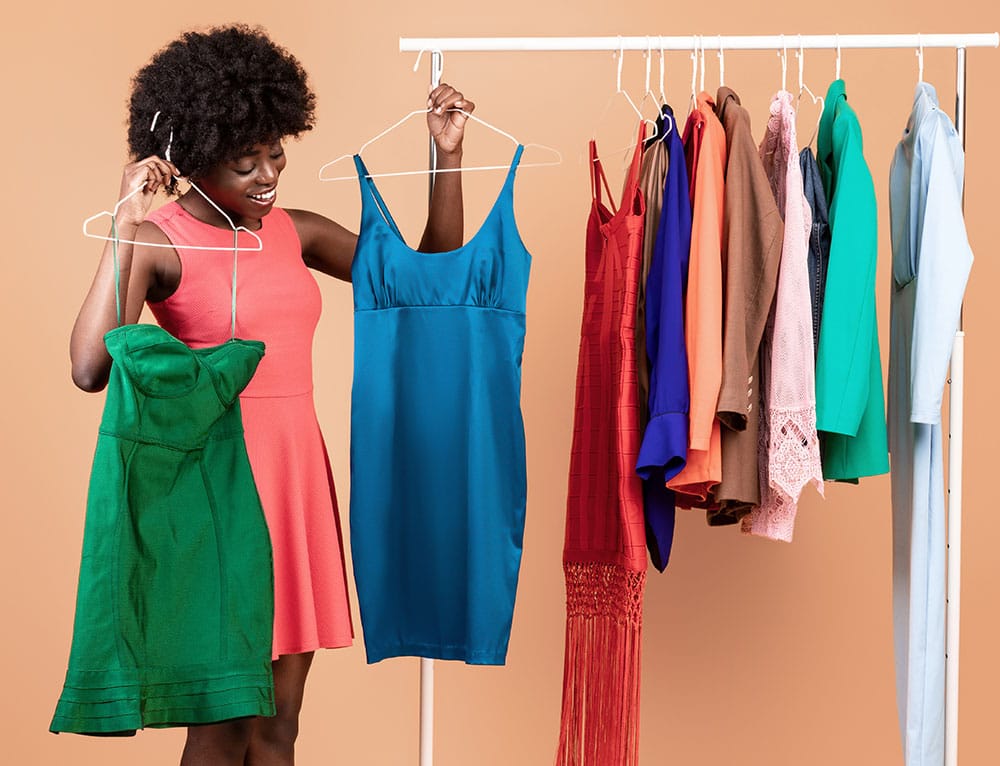
Selling your products effectively requires a well-planned strategy that balances direct-to-consumer (DTC) sales, retail partnerships, and e-commerce. Many emerging fashion brands start with their own online store, leveraging platforms like Shopify, Etsy, or WooCommerce to maintain full control over branding, pricing, and customer experience. Additionally, collaborating with boutiques, department stores, or online marketplaces like Farfetch and Net-a-Porter can expand reach and credibility.
A strong omnichannel approach—combining online sales, pop-up shops, and social commerce—helps brands maximize visibility and engagement. Social media platforms like Instagram and TikTok Shop have become key selling tools, allowing brands to showcase products in real time and drive impulse purchases. Successful brands like Jacquemus and Skims have mastered DTC and digital-first selling, proving that a well-executed sales strategy is just as important as great design. Understanding pricing, customer behaviour, and distribution channels ensure long-term growth and profitability (Business of Fashion, 2023; McKinsey & Company, 2022; Vogue, 2021).
Choosing the Right Sales Channels: E-commerce, Brick-and-Mortar, and Third-Party Retailers
Choosing the right sales channels is key to maximizing reach, sales, and brand positioning in the fashion industry. E-commerce platforms like Shopify, Etsy, and WooCommerce offer direct-to-consumer (DTC) sales, allowing brands to control pricing, branding, and customer experience while reducing overhead costs. Many modern brands, such as Skims and Jacquemus, thrive through digital-first strategies, leveraging social media-driven sales.
Brick-and-mortar stores provide a tactile shopping experience, which is valuable for luxury and high-end brands. Opening a flagship store or partnering with boutiques can enhance brand credibility and offer customers personalized service. Meanwhile, third-party retailers like Farfetch, Net-a-Porter, and department stores help brands expand their audience without managing their own physical stores. Successful fashion businesses often adopt a multi-channel approach, blending online and offline sales to reach different customer segments while ensuring flexibility and scalability (Business of Fashion, 2023; McKinsey & Company, 2022; Vogue, 2021).
Pricing Your Products: Balancing Affordability and Profitability
Pricing in fashion requires balancing affordability and profitability while considering production costs, brand positioning, and perceived value. Setting prices too high can alienate customers, while pricing too low may undervalue the brand and cut into profit margins. Many brands use cost-based pricing (covering production, marketing, and logistics with a markup) or value-based pricing (reflecting exclusivity, craftsmanship, or brand prestige). Luxury brands like Dior emphasize exclusivity with premium pricing, while Zara thrives on competitive, volume-driven pricing. Offering tiered pricing, limited editions, or bundles can also optimize revenue. The key is aligning pricing with brand identity and customer expectations while ensuring sustainable profit margins (Business of Fashion, 2023; McKinsey & Company, 2022; Vogue, 2021).
Creating an Unforgettable Customer Experience: Packaging, Customer Service, and Follow-Ups
Customer experience goes beyond the product, encompassing packaging, service, and follow-ups to build loyalty and brand reputation. Thoughtful packaging—such as eco-friendly materials, unique unboxing experiences, and personalized touches—enhances perceived value and creates a lasting impression. Customer service should be seamless, offering quick responses, hassle-free returns, and personalized support to build trust. Follow-ups, like thank-you emails, exclusive offers, or feedback requests, strengthen customer relationships and encourage repeat purchases. Brands like Apple and Chanel invest in premium customer experiences, proving that details matter. A memorable interaction ensures brand differentiation and long-term customer retention (Business of Fashion, 2023; McKinsey & Company, 2022; Vogue, 2021).
10. Learning from Industry Leaders
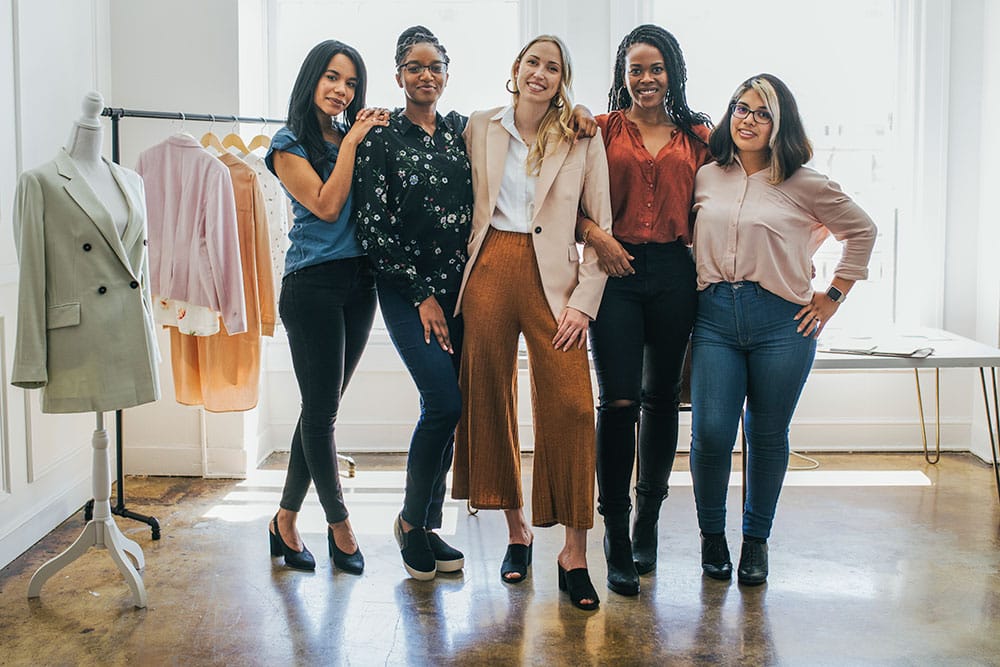
Studying industry leaders provides valuable insights into branding, innovation, and business strategy. Successful designers like Coco Chanel, Virgil Abloh, and Stella McCartney revolutionized fashion by blending creativity with market awareness, adapting to trends while staying true to their vision. Observing how brands handle marketing, sustainability, and customer engagement helps emerging designers refine their approach. From Louis Vuitton’s luxury dominance to Nike’s storytelling-driven marketing, industry leaders demonstrate that success comes from innovation, consistency, and strategic growth. Learning from their journeys helps new brands navigate challenges and carve out their own niche in the competitive fashion world (Business of Fashion, 2023; McKinsey & Company, 2022; Vogue, 2021).
Tips from Established Designers: Insights on overcoming obstacles and achieving success
Successful designers emphasize resilience, adaptability, and authenticity as keys to overcoming industry challenges. Virgil Abloh broke barriers by merging streetwear with high fashion, proving that innovation thrives at the intersection of cultures. Stella McCartney championed sustainability before it became mainstream, showing that staying true to values builds lasting brands. Many designers highlight the importance of networking, storytelling, and strategic collaborations in scaling a brand. Learning from failures, staying ahead of trends, and maintaining a strong brand identity help designers navigate setbacks and sustain growth. Success in fashion isn’t just about talent—it’s about vision, persistence, and smart business moves (Business of Fashion, 2023; McKinsey & Company, 2022; Vogue, 2021).
Innovative Approaches: How They Embraced Technology, Sustainability, or Cultural Relevance
Top designers have embraced technology, sustainability, and cultural relevance to redefine fashion. Balenciaga and Gucci pioneered digital fashion and virtual runways, integrating AI and NFTs into their strategies. Stella McCartney and Patagonia led the shift toward eco-friendly materials, proving that ethical fashion can be profitable. Meanwhile, Virgil Abloh and Telfar reshaped inclusivity by making fashion more accessible and culturally resonant. Leveraging 3D design, upcycling, and social media-driven branding, these innovators show that staying ahead requires adapting to change while staying authentic (Business of Fashion, 2023; McKinsey & Company, 2022; Vogue, 2021).
Failures and Lessons Learned: What Successful Designers Wish They Had Done Differently
Failures in fashion often stem from scaling too fast, poor financial planning, or losing brand identity. Christian Lacroix struggled with profitability despite critical acclaim, highlighting the need for a strong business strategy alongside creativity. John Galliano’s downfall underscored the importance of brand reputation and personal conduct in a highly scrutinized industry. Many designers, like Tom Ford, emphasize learning from mistakes—whether underestimating production costs, neglecting digital marketing, or ignoring customer feedback. The key lesson? Success requires a balance between creativity and business acumen, constant adaptation, and a clear, sustainable vision (Business of Fashion, 2023; McKinsey & Company, 2022; Vogue, 2021).
11. Staying Relevant and Growing Your Brand
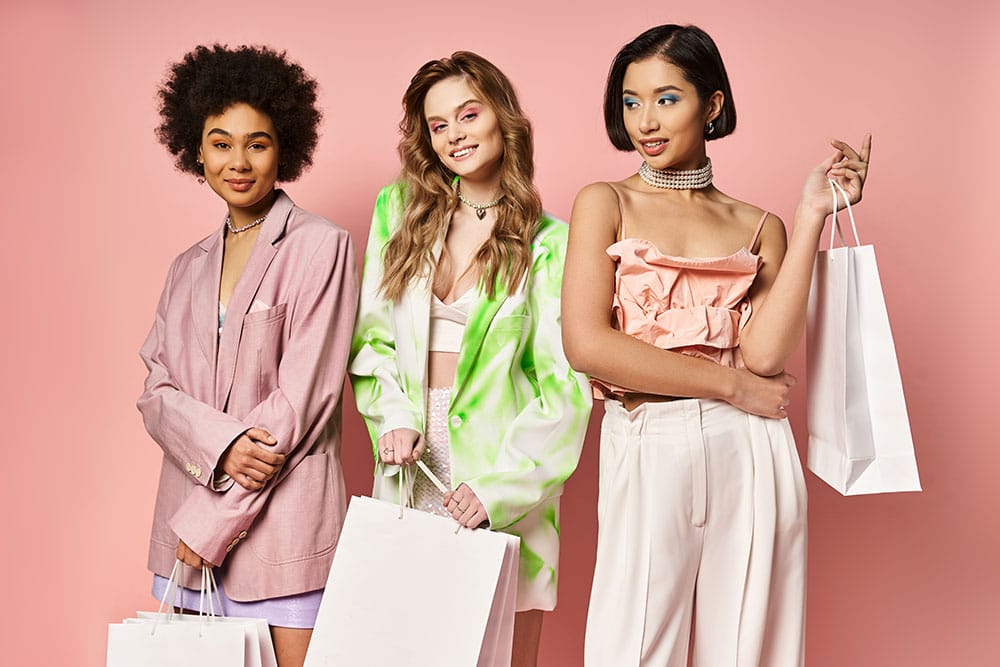
Staying relevant in fashion requires innovation, adaptability, and strong brand identity. Trends evolve quickly, and brands must balance timeless appeal with fresh ideas to maintain consumer interest. Leveraging social media, influencer marketing, and technological advancements keeps brands visible in a competitive market. Expanding through collaborations, new product lines, or sustainable initiatives helps brands grow while maintaining authenticity. Successful labels like Balenciaga and Jacquemus stay relevant by pushing creative boundaries and engaging with culture. Long-term success comes from listening to consumers, evolving strategically, and consistently delivering quality and innovation (Business of Fashion, 2023; McKinsey & Company, 2022; Vogue, 2021).
Adapting to Trends: Evolving with Changing Fashion Preferences
Adapting to trends is essential for staying relevant while maintaining a brand’s unique identity. Successful designers balance trend forecasting, consumer behavior analysis, and brand DNA to evolve without losing authenticity. Brands like Gucci and Balenciaga stay ahead by embracing streetwear, digital fashion, and cultural shifts, while others, like Chanel, focus on timeless elegance with modern updates. Social media, influencer culture, and AI-driven analytics help brands anticipate and react to changing preferences. The key is to innovate while staying true to the brand’s core values, ensuring long-term consumer loyalty and industry influence (Business of Fashion, 2023; McKinsey & Company, 2022; Vogue, 2021).
Expanding Your Product Line: Introducing Accessories, Shoes, or Other Categories
Expanding a product line allows fashion brands to diversify revenue, attract new customers, and strengthen brand identity. Many labels start with apparel before adding accessories, shoes, bags, or fragrances, as seen with Louis Vuitton and Prada. Successful expansion requires aligning new products with the brand’s core aesthetic and market demand. Strategic launches, like Jacquemus’ mini bags or Skims’ shapewear, create hype while reinforcing brand positioning. Careful planning ensures quality, consistency, and seamless integration, preventing overextension. Growth should be purposeful, consumer-driven, and in line with the brand’s long-term vision (Business of Fashion, 2023; McKinsey & Company, 2022; Vogue, 2021).
Building Long-Term Relationships: Retaining Loyal Customers and Suppliers
Building long-term relationships with customers and suppliers ensures brand stability and sustainable growth. Consistent quality, personalized experiences, and strong communication foster customer loyalty, as seen with brands like Hermès and Chanel, which emphasize exclusivity and exceptional service. Engaging through loyalty programs, exclusive drops, and responsive customer support strengthens retention. Maintaining reliable supplier relationships through fair pricing, ethical practices, and transparent partnerships ensures smooth production and long-term trust. A brand’s success isn’t just about gaining new customers—it’s about nurturing lasting connections that drive repeat business and industry credibility (Business of Fashion, 2023; McKinsey & Company, 2022; Vogue, 2021).
12. Embracing Sustainability and Ethical Practices
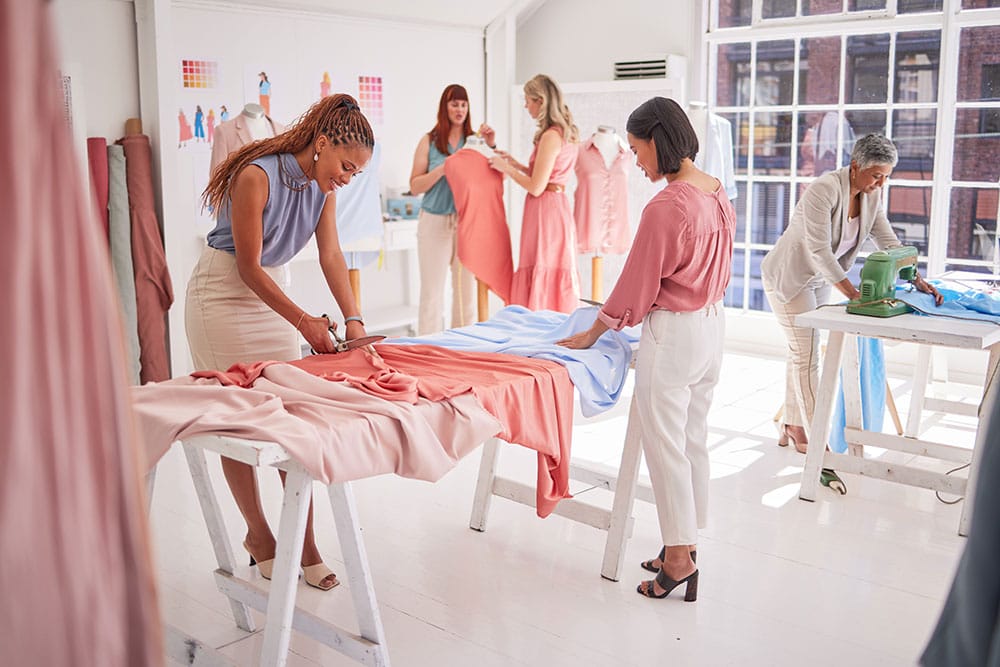
Embracing sustainability and ethical practices is essential for modern fashion brands to stay relevant and responsible. Consumers increasingly demand eco-friendly materials, fair labor practices, and transparent supply chains, pushing brands to adopt more sustainable approaches. Labels like Stella McCartney and Patagonia lead by using organic fabrics, recycled materials, and ethical sourcing to minimize environmental impact. Implementing slow fashion, circular production models, and carbon footprint reduction strategies not only benefits the planet but also strengthens brand reputation. Prioritizing ethics in both design and production ensures long-term industry credibility and customer loyalty (Business of Fashion, 2023; McKinsey & Company, 2022; Vogue, 2021).
The Importance of Eco-Friendly Fashion: Materials, Production, and Packaging
Eco-friendly fashion prioritizes sustainable materials, ethical production, and responsible packaging to reduce environmental impact. Brands like Stella McCartney and Patagonia use organic cotton, recycled fabrics, and vegan alternatives to minimize waste and pollution. Sustainable production involves reducing water usage, cutting carbon emissions, and ensuring fair labor practices, while eco-conscious packaging replaces plastics with biodegradable or reusable materials. Consumers increasingly support brands that embrace sustainability, making ethical fashion both a moral responsibility and a competitive advantage in today’s market (Business of Fashion, 2023; McKinsey & Company, 2022; Vogue, 2021).
Promoting Transparency: Communicating Your Sustainability Practices
Transparency in sustainability builds trust, credibility, and customer loyalty by openly sharing a brand’s ethical practices, sourcing, and production methods. Leading brands like Everlane and Patagonia disclose factory conditions, material origins, and carbon footprints, allowing consumers to make informed choices. Clear communication through website reports, social media updates, and third-party certifications (e.g., GOTS, Fair Trade) reinforces authenticity. Consumers value brands that back their claims with data and accountability, making transparency not just an ethical commitment but also a competitive advantage in the sustainable fashion market (Business of Fashion, 2023; McKinsey & Company, 2022; Vogue, 2021).
Making an Impact: Aligning Your Fashion Line With Global Movements for Good
Aligning a fashion brand with global movements amplifies impact, strengthens brand identity, and attracts socially conscious consumers. Successful brands like TOMS and Stella McCartney integrate ethical labor, sustainability, and social activism into their business models, supporting causes like climate action, gender equality, and fair wages. Partnering with nonprofits, advocating for policy changes, or using proceeds for charitable initiatives enhances credibility and consumer trust. In today’s market, fashion isn’t just about style—it’s about driving positive change while building a loyal, values-driven community (Business of Fashion, 2023; McKinsey & Company, 2022; Vogue, 2021).
13. Challenges and How to Overcome Them
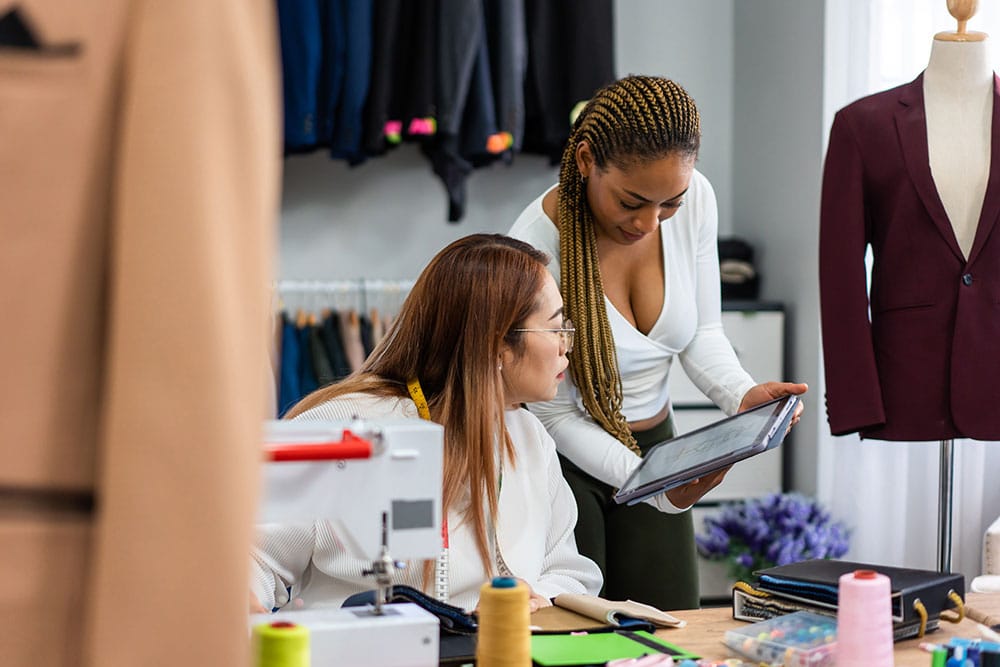
Navigating challenges in the fashion industry requires resilience, adaptability, and strategic planning. Common obstacles include financial constraints, supply chain disruptions, and intense competition, which can be mitigated through smart budgeting, strong supplier relationships, and unique brand positioning. Changing consumer trends demand continuous innovation, with brands like Balenciaga and Jacquemus thriving by staying culturally relevant. Marketing struggles can be addressed through digital engagement, influencer collaborations, and storytelling. The key to long-term success is embracing challenges as opportunities for growth, learning from failures, and maintaining a clear brand vision (Business of Fashion, 2023; McKinsey & Company, 2022; Vogue, 2021).
Dealing with Competition: Standing Out in a Saturated Market
Standing out in a saturated market requires strong brand identity, innovation, and strategic marketing. Successful brands like Jacquemus and Off-White differentiate themselves through storytelling, unique aesthetics, and cultural relevance. Leveraging niche markets, sustainability, or exclusive collaborations can create a competitive edge. Engaging directly with consumers via social media, experiential marketing, and personalized customer experiences builds brand loyalty. The key is to stay authentic, adapt to trends without losing identity, and consistently deliver quality and originality (Business of Fashion, 2023; McKinsey & Company, 2022; Vogue, 2021).
Managing Finances: Avoiding Overspending and Cash Flow Issues
Managing finances in fashion requires careful budgeting, cost control, and cash flow management to avoid overspending. Brands must track production costs, marketing expenses, and operational overhead while ensuring sustainable profit margins. Successful designers like Tom Ford and Jacquemus balance creativity with financial discipline, investing strategically in scalable growth rather than unnecessary expenses. Using inventory management systems, forecasting sales trends, and securing multiple revenue streams (e.g., pre-orders, collaborations) helps maintain stability. Smart financial planning ensures long-term success, preventing liquidity crises and supporting sustainable brand expansion (Business of Fashion, 2023; McKinsey & Company, 2022; Vogue, 2021).
Balancing Creativity with Practicality: Meeting Business Goals without Compromising Your Vision
Balancing creativity with practicality requires merging artistic vision with strategic decision-making to sustain a profitable fashion brand. Designers like Alexander McQueen and Rick Owens push creative boundaries while ensuring their collections remain marketable and wearable. Setting clear business goals, understanding customer demand, and optimizing production costs helps maintain financial stability without diluting brand identity. Leveraging limited-edition drops, collaborations, and digital innovation allows brands to stay experimental while driving sales. The key is to innovate within a structured framework, ensuring long-term growth without sacrificing artistic integrity (Business of Fashion, 2023; McKinsey & Company, 2022; Vogue, 2021).
14. Case Studies: Inspiration From the Top
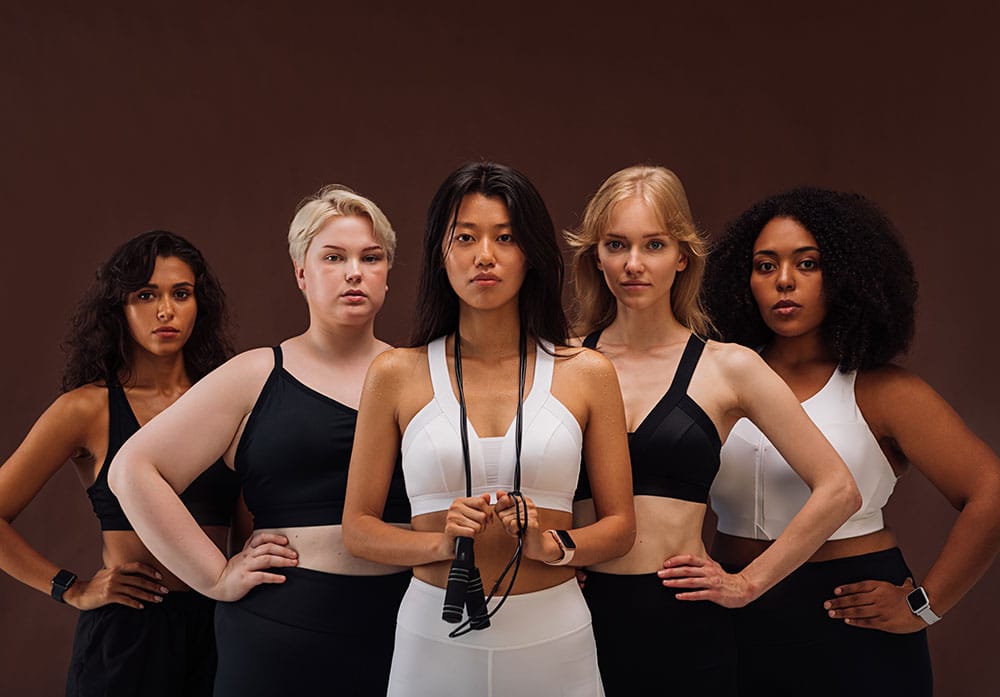
Case studies of top fashion brands offer valuable insights into brand growth, innovation, and market adaptation. Labels like Jacquemus and Off-White succeeded by blending unique aesthetics with cultural relevance, while Chanel and Hermès built legacies through timeless luxury and exclusivity. Zara revolutionized fast fashion with rapid production cycles, and Stella McCartney led sustainability efforts long before it became mainstream. Studying these brands reveals that success comes from strategic vision, adaptability, and strong brand identity, proving that creativity must align with business acumen for long-term impact (Business of Fashion, 2023; McKinsey & Company, 2022; Vogue, 2021).
Spotlight on Successful Designers: Analyze Their Paths to Success (e.g., Coco Chanel, Virgil Abloh, Stella McCartney)
Successful designers like Coco Chanel, Virgil Abloh, and Stella McCartney built their legacies by merging vision, innovation, and business strategy. Chanel revolutionized womenswear with minimalist elegance, timeless branding, and a strong luxury identity. Abloh broke industry barriers by blending streetwear with high fashion, leveraging collaborations and cultural influence to create Off-White’s global success. McCartney, a pioneer in sustainable fashion, proved that ethical practices and high fashion could coexist, setting industry standards. Their paths highlight the importance of brand storytelling, adaptability, and aligning creativity with commercial success, offering key lessons for emerging designers (Business of Fashion, 2023; McKinsey & Company, 2022; Vogue, 2021).
Key Takeaways from Their Stories: Lessons on Persistence, Innovation, and Branding
Successful designers teach key lessons in persistence, innovation, and branding. Coco Chanel proved that timeless design and strong brand identity create lasting success. Virgil Abloh redefined fashion by embracing cultural relevance, collaborations, and digital engagement, showing that innovation comes from blending disciplines. Stella McCartney demonstrated that sustainability and luxury can coexist, influencing industry-wide shifts. Their journeys emphasize the power of authentic storytelling, adaptability, and strategic growth, proving that success in fashion requires a balance of creativity, resilience, and business acumen (Business of Fashion, 2023; McKinsey & Company, 2022; Vogue, 2021).
15. Conclusion
Starting a fashion line requires a blend of creativity, strategy, and persistence. From defining a clear vision and researching the market to building a strong brand identity, managing production, and executing effective marketing, each step is crucial to success. Choosing the right sales channels, pricing strategy, and sustainability practices ensures long-term growth while maintaining authenticity. Learning from industry leaders like Coco Chanel, Virgil Abloh, and Stella McCartney highlights the importance of innovation, adaptability, and strategic branding in standing out in a competitive market. Fashion is not just about clothing—it’s about telling a story and connecting with consumers on a deeper level.
Perseverance and continuous learning are essential in an industry that is constantly evolving. Challenges will arise, but staying committed to your vision, embracing new trends, and refining your craft will push your brand forward. Whether through trial and error, networking, or strategic collaborations, every step is part of the journey. Trust your instincts, stay authentic, and create something uniquely yours—because true success in fashion comes from blending passion with purpose (Business of Fashion, 2023; McKinsey & Company, 2022; Vogue, 2021).
Written by: Alireza Bahram
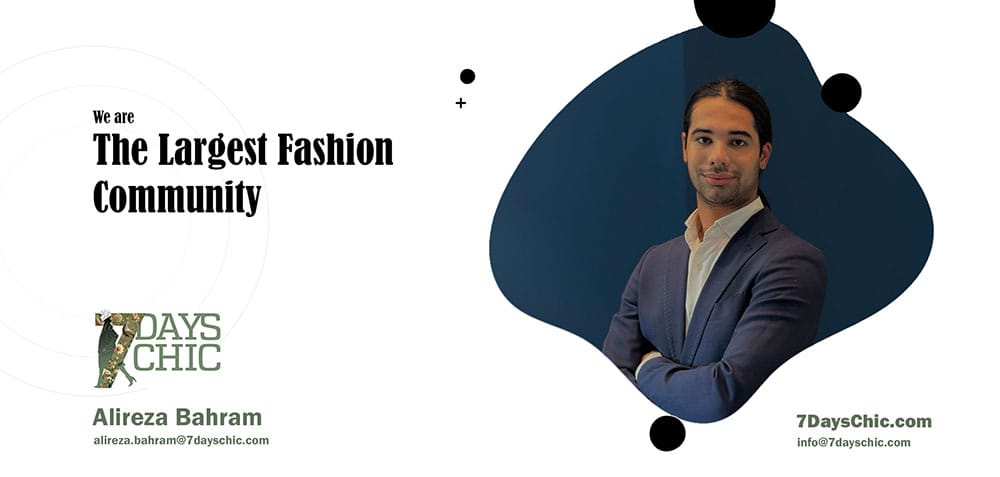


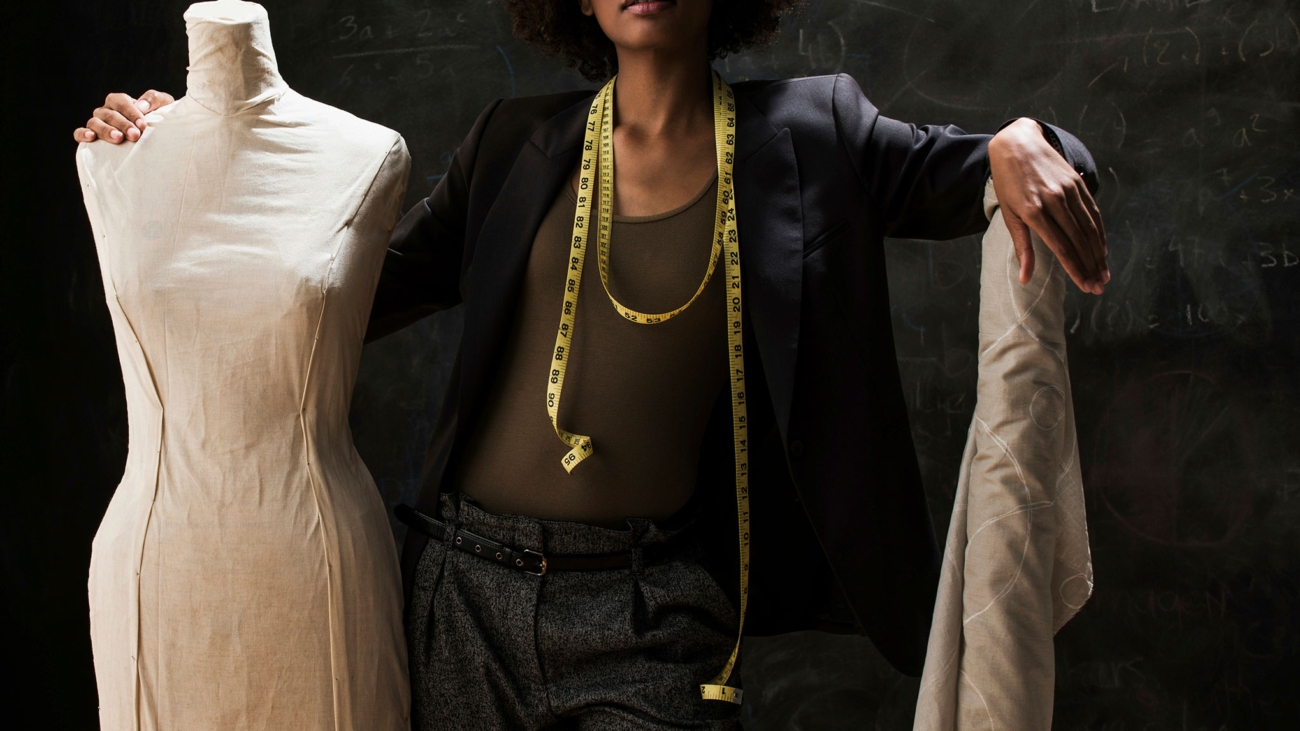
Add a Comment